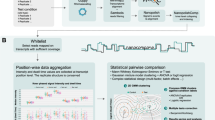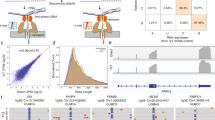Abstract
RNA modifications exist in all kingdom of life. Several different types of base or ribose modifications are now summarized under the term “epitranscriptome.” With the advent of high-throughput sequencing technologies, much progress has been made in understanding RNA modification biology and how these modifications can influence many aspects of RNA life. The most widespread internal modification on mRNA is m6A, which has been implicated in physiological processes as well as disease pathogenesis. Here, we provide a workflow for the map** of m6A sites using Nanopore direct RNA sequencing data. Our strategy employs pairwise comparison of basecalling error profiles with JACUSA2. We outline a general strategy for RNA modification detection on mRNA and describe two specific use cases on m6A detection in detail. Use case 1: a sample of interest with modifications (e.g., “wild-type” sample) is compared to a sample lacking a specific modification type (e.g., “knockout” sample, here METTL3-KO) or Use case 2: a sample of interest with modifications is compared to a sample lacking all modifications (e.g., in vitro transcribed cDNA). We provide a detailed protocol on experimental and computational aspects. Extensive online material provides a snakemake pipeline to identify m6A positions in mRNA and to validate the results against a miCLIP-derived m6A reference set. The general strategy is flexible and can be easily adapted by users in different application scenarios.
Access this chapter
Tax calculation will be finalised at checkout
Purchases are for personal use only
Similar content being viewed by others
References
Atlasi Y, Stunnenberg HG (2017) The interplay of epigenetic marks during stem cell differentiation and development. Nat Rev Genet 18(11):643–658. https://doi.org/10.1038/nrg.2017.57
Nishikura K (2010) Functions and regulation of RNA editing by ADAR deaminases. Annu Rev Biochem 79:321–349. https://doi.org/10.1146/annurev-biochem-060208-105251
Frye M, Harada BT, Behm M, He C (2018) RNA modifications modulate gene expression during development. Science 361(6409):1346–1349. https://doi.org/10.1126/science.aau1646
Worpenberg L, Paolantoni C, Roignant J-Y (2022) Functional interplay within the epitranscriptome: reality or fiction? BioEssays News Rev Mol Cell Dev Biol 44(2):e2100174. https://doi.org/10.1002/bies.202100174
Roundtree IA, Evans ME, Pan T, He C (2017) Dynamic RNA modifications in gene expression regulation. Cell 169(7):1187–1200. https://doi.org/10.1016/j.cell.2017.05.045
Anreiter I, Mir Q, Simpson JT, Janga SC, Soller M (2021) New twists in detecting mRNA modification dynamics. Trends Biotechnol 39(1):72–89. https://doi.org/10.1016/j.tibtech.2020.06.002
Roignant J-Y, Soller M (2017) m, javax.xml.bind.JAXBElement@8cec19d, A in mRNA: an ancient mechanism for fine-tuning gene expression. Trends Genet TIG 33(6):380–390. https://doi.org/10.1016/j.tig.2017.04.003
Zaccara S, Ries RJ, Jaffrey SR (2019) Reading, writing and erasing mRNA methylation. Nat Rev Mol Cell Biol 20(10):608–624. https://doi.org/10.1038/s41580-019-0168-5
Shi H, Wei J, He C (2019) Where, when, and how: context-dependent functions of RNA methylation writers, readers, and erasers. Mol Cell 74(4):640–650. https://doi.org/10.1016/j.molcel.2019.04.025
Garcias Morales D, Reyes JL (2021) A birds’-eye view of the activity and specificity of the mRNA m, javax.xml.bind.JAXBElement@6d66739e, A methyltransferase complex. Wiley Interdiscip Rev RNA 12(1):e1618. https://doi.org/10.1002/wrna.1618
Jia G et al (2011) N6-methyladenosine in nuclear RNA is a major substrate of the obesity-associated FTO. Nat Chem Biol 7(12):885–887. https://doi.org/10.1038/nchembio.687
Zheng G et al (2013) ALKBH5 is a mammalian RNA demethylase that impacts RNA metabolism and mouse fertility. Mol Cell 49(1):18–29. https://doi.org/10.1016/j.molcel.2012.10.015
Dominissini D et al (2012) Topology of the human and mouse m6A RNA methylomes revealed by m6A-seq. Nature 485(7397):201–206. https://doi.org/10.1038/nature11112
Meyer KD, Saletore Y, Zumbo P, Elemento O, Mason CE, Jaffrey SR (2012) Comprehensive analysis of mRNA methylation reveals enrichment in 3’ UTRs and near stop codons. Cell 149(7):1635–1646. https://doi.org/10.1016/j.cell.2012.05.003
Ke S et al (2015) A majority of m6A residues are in the last exons, allowing the potential for 3’ UTR regulation. Genes Dev 29(19):2037–2053. https://doi.org/10.1101/gad.269415.115
Adhikari S, **ao W, Zhao Y-L, Yang Y-G (2016) m(6)A: Signaling for mRNA splicing. RNA Biol 13(9):756–759. https://doi.org/10.1080/15476286.2016.1201628
Wang X et al (2015) N6-methyladenosine modulates messenger RNA translation efficiency. Cell 161(6):1388–1399
Wang X et al (2014) N 6-methyladenosine-dependent regulation of messenger RNA stability. Nature 505(7481):117–120
Du H et al (2016) YTHDF2 destabilizes m 6 A-containing RNA through direct recruitment of the CCR4–NOT deadenylase complex. Nat Commun 7(1):1–11
Patil DP, Pickering BF, Jaffrey SR (2018) Reading m6A in the transcriptome: m6A-binding proteins. Trends Cell Biol 28(2):113–127
Zhang Z et al (2021) Systematic calibration of epitranscriptomic maps using a synthetic modification-free RNA library. Nat Methods 18(10):1213–1222
Minimap2. [Online]. Available: https://github.com/lh3/minimap2
Piechotta M, Wang Q, Altmüller J, Dieterich C (2021) RNA modification map** with JACUSA2. bioRxiv
Köster J, Rahmann S (2012) Snakemake—a scalable bioinformatics workflow engine. Bioinformatics 28(19):2520–2522
Pratanwanich PN et al (2021) Identification of differential RNA modifications from nanopore direct RNA sequencing with xPore. Nat Biotechnol 39(11):1394–1402
Boulias K et al (2019) Identification of the m6Am methyltransferase PCIF1 reveals the location and functions of m6Am in the transcriptome. Mol Cell 75(3):631–643
Koh CW, Goh YT, Goh WS (2019) Atlas of quantitative single-base-resolution N 6-methyl-adenine methylomes. Nat Commun 10(1):1–15
Körtel N et al (2021) Deep and accurate detection of m6A RNA modifications using miCLIP2 and m6Aboost machine learning. bioRxiv:2020–2012
JACUSA2 manual. 2021. [Online]. Available: https://github.com/dieterich-lab/JACUSA2
Lee DD, Seung HS (1999) Learning the parts of objects by non-negative matrix factorization. Nature 401(6755):788–791
Frigyesi A, Höglund M (2008) Non-negative matrix factorization for the analysis of complex gene expression data: identification of clinically relevant tumor subtypes. Cancer Inform 6:CIN-S606
Rousseeuw PJ (1987) Silhouettes: a graphical aid to the interpretation and validation of cluster analysis. J Comput Appl Math 20:53–65
Brunet J-P, Tamayo P, Golub TR, Mesirov JP (2004) Metagenes and molecular pattern discovery using matrix factorization. Proc Natl Acad Sci 101(12):4164–4169
Acknowledgments
The authors would like to thank Harald Wilhemi for testing the snakemake pipeline. This work was supported by DFG SPP 1784 (DI1501/11-1) and DFG TRR 319 – RMaP.
Author information
Authors and Affiliations
Corresponding author
Editor information
Editors and Affiliations
Rights and permissions
Copyright information
© 2023 The Author(s), under exclusive license to Springer Science+Business Media, LLC, part of Springer Nature
About this protocol
Cite this protocol
Lemsara, A., Dieterich, C., Naarmann-de Vries, I.S. (2023). Map** of RNA Modifications by Direct Nanopore Sequencing and JACUSA2. In: Oliveira, P.H. (eds) Computational Epigenomics and Epitranscriptomics. Methods in Molecular Biology, vol 2624. Humana, New York, NY. https://doi.org/10.1007/978-1-0716-2962-8_16
Download citation
DOI: https://doi.org/10.1007/978-1-0716-2962-8_16
Published:
Publisher Name: Humana, New York, NY
Print ISBN: 978-1-0716-2961-1
Online ISBN: 978-1-0716-2962-8
eBook Packages: Springer Protocols




